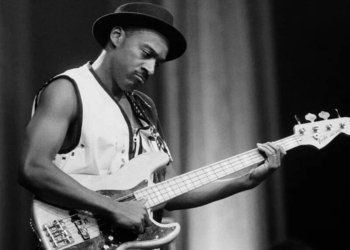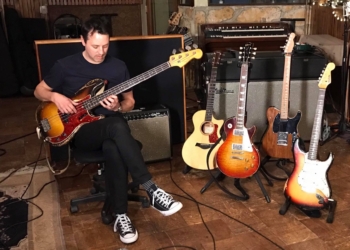If you’ve ever watched a Taylor Swift concert and found yourself wondering who’s holding down the low end with all that swagger and precision, let me introduce you to Amos Heller, the bass player who blends heavy metal roots with arena-ready professionalism.
Amos isn’t just a bassist, he’s a full-spectrum musician with a foot in both the classical and metal worlds. While most people know him for anchoring the rhythm section on Swift’s massive tours, real heads know this guy’s story runs much deeper.

From Upright Bass to Megadeth, With a Detour Through Nashville
Amos started young, borrowing his school’s upright bass to learn songs from albums that had zero business being played on orchestral instruments. While his teachers taught him Bach, he was secretly ripping through Metallica and Sepultura at home.
He stuck with classical upright for a decade, but metal was always there in the background, pushing him to develop insane chops and endurance. After cutting his teeth in Cincinnati, he made his way to Nashville, quickly becoming a first-call bassist both in studios and on tours.
That all led to a career-defining moment in 2007, when he joined the young Taylor Swift as her bass player just as her star was beginning to rise. Now, almost twenty years later, he’s become a fan favorite with Swifties and an integral part of one of the most polished and high-powered live acts in the world.

What’s something fans might be surprised you listen to?
While it might not come as a huge surprise anymore, Amos Heller is a metalhead through and through. He cut his teeth on thrash legends like Metallica and Megadeth, and he’s never been shy about his love for Faith No More, Pantera, and Sepultura. These days, his playlist leans toward bands like Ghost and Four Year Strong, along with The Paradigm Shift by Korn. If Jacob Umansky drops something new, Amos is probably already listening.
That metal edge translates into his playing, but behind the scenes, he’s constantly pushing himself in new directions. One of his favorite drills involves picking a random key, firing up a drum loop, and setting an eight-minute timer. The goal? Build a tight, creative four-bar groove before time runs out. It’s a simple structure that forces him to stay sharp and listen deeply. From pick technique and endurance to ear training and melody transcriptions, Amos treats practice like a craft, not a chore – and that’s a big part of why he continues to evolve as a player.
Amos Heller’s very first concert set the bar impossibly high. At just six years old, his parents took him to see Talking Heads on the iconic Stop Making Sense tour. He doesn’t remember all the details, but the fact that he was there? That’s a lifetime brag. While most people grow up and eventually realize their parents were just regular humans trying to figure things out, Amos had a different realization, his parents were legitimately cool.
Years later, another concert would leave a permanent mark on him. Seeing Paul McCartney live was nothing short of life-changing. The performance, the band, the energy, all of it blew him away. McCartney’s ability to command a stage after decades in the game, while still delivering hit after hit from one of the most legendary catalogs in music history, was staggering. “I left that show completely inspired,” Amos said. And for a guy who plays some of the biggest stages on Earth, that says a lot.
Bass Icons, Metal Heroes, and the Dream Lunch Table
When it comes to musical influences and idols, Amos doesn’t hold back. If he could sit down for lunch with any bass players, he’d build an all-star table. For a peek into the business side of music, he’d pick Chris Chaney.
To just sit in stunned awe, it would be Cliff Burton – the late Metallica legend who helped shape Amos’s playing from the very beginning. For a thoughtful, great conversation? Bryan Beller. And if we’re talking pure clout, who wouldn’t want to say they had lunch with Flea?
Speaking of Metallica, if Amos could step into any band as a sub, it would be to fill in for Robert Trujillo. That band shaped the very foundation of his musical identity. As a teenager, he was learning Kill ’Em All on his upright bass and idolizing Cliff Burton, who remains one of his all-time heroes to this day.

First Basses, One-Finger Grooves, and Unexpected Wardrobe Fails
Amos still remembers his very first bass – an Ibanez EXB 404 that he got when he was 13. It was lightweight, sleek, and the moment he got it, he covered it in surf stickers. Ironically, he only went surfing once, years later, but hey, the aesthetic mattered. He’s even been thinking about trying to track that bass down, just for the nostalgia.
One of the best pieces of advice he ever got about bass playing came from a drummer friend, who encouraged him to practice using just one finger on his plucking hand. It completely changed the game. That kind of constraint forced him to focus on tone, control, and restraint – letting the groove breathe. On the Eras Tour, he’d warm up by running through a playlist using only his right pointer finger. If he could make it through the instrumental break in Rush’s Tom Sawyer, he knew he was locked in.
Of course, not everything on stage always goes to plan. During a mid-show costume change, Amos once managed to rip a giant hole in his pants without realizing it. He went on to play for another thirty minutes, blissfully unaware that he was mooning part of the arena. It happens.
Whether he’s performing for hundreds of thousands of fans or riffing alone in his Nashville home, Amos Heller brings intensity, humility, and a whole lot of low-end power to everything he does. He’s more than just the bass player for Taylor Swift, he’s a deeply dedicated artist with a love for the craft and a wicked sense of humor to match.





